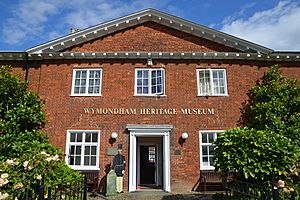Wymondham Bridewell facts for kids
The Wymondham Bridewell was a local prison, also known as a "bridewell" or "lock-up," located in the town of Wymondham, Norfolk, England. This site was used as a prison as early as 1619. The building you see today, which is a special historic building (Grade II listed), was built in the 1780s. It stopped being a prison in 1878. After that, it was used for different things, like a police station and a courthouse. Today, the main part of the building is home to the Wymondham Heritage Museum.
Contents
What Was Wymondham Bridewell?
The Wymondham Bridewell was designed in a square shape. In the 1820s, the Governor's (the person in charge) house was at the front. The prison cells were on the sides, and a treadmill was at the back. There were 22 cells in total. Most of these cells were about 12 feet by 7 feet in size. They had brick floors and usually contained two or three iron beds for prisoners.
Life Inside the Bridewell
In 1824, the prison had a Governor, two turnkeys (guards), and a miller (who operated the treadmill). The prison was organized into two main areas or "classes" for prisoners. It also had two wards, a treadmill, three day-rooms for activities, and two outdoor yards for exercise. There was also a special yard for the mill.
After 1827, the Bridewell was empty for a few years. It reopened in 1832, mainly to hold women prisoners. By 1842, there were usually about 19 prisoners there. Even though it was mostly a women's prison by 1853, it was sometimes used to temporarily hold men who were waiting to be moved to another prison. This included some prisoners who were considered quite dangerous.
Daily Life for Prisoners
By the 1850s, the conditions at Wymondham Bridewell seemed quite fair. A report from 1853 showed there were only 19 prisoners. Five of these prisoners were under 16 years old. The Matron (a female officer) taught the women how to read and write. The Chaplain (a religious leader) held regular services and gave lessons. Many prisoners found jobs after they were released.
The prisoners worked on various tasks. These included washing, ironing, making mats, knitting, needlework, and cleaning the prison. The women at Wymondham Bridewell also made, mended, and washed the linen for Norwich Castle Prison, as well as their own. This work was very valuable at the time.
External Links
- Wymondham Heritage Museum - official site
- A 1786 description
- The local Quaker meeting currently worships in part of the building
Images for kids


